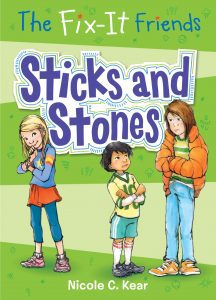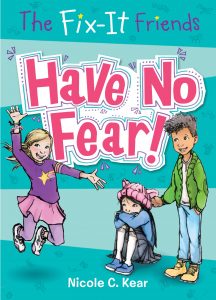I just finished reading The Fix-It Friends: Have No Fear, which is the first in a series of children’s books by Nicole Kear. These beginner chapter books tell the story of a group of four friends (a brother-sister duo and two of their buddies) who help children with big problems. The first book covers an intense fear of spiders while the second installment deals with bullying.
The Fix-It Friends books are chockfull of solid helpful advice for kids and parents on how to solve real problems. The advice that the kids reveal is clearly developed from evidence-based best practices for working through these issues. For example, in Have No Fear kids learn to talk back to their worry and to take baby steps to conquer fears. In Sticks and Stones the friends advise kids being teased to keep a poker face, walk away and ask a grown up for help. The books also provide parents with additional resources and a website with even more information.
But unlike other “helping” books Fix-It Friends reads like just a great story. The characters are fully developed with interesting backstories. One character has Italian grandparents, a dad who is a super in an apartment building and a mother who is a therapist (a great source of professional insight). Also, the characters are from very diverse groups. The Principal and her son (a Fix-It Friend) are Jamaican. Another friend is Spanish-speaking. Another aspect of the books that I loved was the relationship between one main character and her brother. They had some typical bickering but when push came to shove they helped and cared for each other. That’s how siblings should be portrayed in kids’ books. Always referencing a pesky brother or a despised sister doesn’t help real kids navigate sibling relationships.
As a parent of a worrier and as a family coach I cannot recommend these books more highly to young readers.
…
My almost 11-year-old son, Emmett, read Sticks and Stones. He is a little old for the series but read it all the same. Here are his thoughts on the book in his own words:
“You get to know the characters and they all were very different. You know what they liked, their friends, what’s happening at school. They had different personalities, too. They also have different ideas, like one person has a babysitter that helps them in the book, one person had a pet hamster.
The book was smart in the way they solved problems and it would work in real life. For example, the book explains not to react if someone is being mean to you. Act like it’s not happening. That would be helpful because it could work. The resources in the back were good for a kid who is being bullied. Kids could definitely use the tools. It also explains concepts so you can know what they are talking about. They use the term poker face and then explain what it is. It means where you don’t show how you are feeling through your face. If I was 7 or so I would think it was funny. Also, I think it’s a good beginning chapter book for younger kids because it has multiple chapters and each chapter isn’t 3 sentences long. They are decent chapters.
Illustrations were great and they helped understand the story more. There was a picture of the playground and then I knew what it looked like.”


